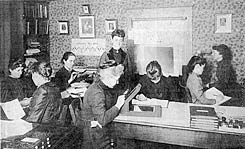Women recruited to the Harvard Observatory at the end of the 19th century contributed greatly to the development of astronomy
Simon Singh Boston Globe, Haaretz, Walla News!

Williamina Fleming (standing) and other women at Harvard examining photographic plates of stars, 1890
Direct link to this page: https://www.hayadan.org.il/womanastronomers.html
When Harvard University President Lawrence Summers recently argued that there may be innate differences between women and men that likely affect their success in science, I was reminded of an extraordinary story about women scientists at Harvard University in the late 19th and early 20th centuries.
In 1877 Edward Pickering was appointed director of the Harvard Observatory and initiated a program to photograph the night sky. The observatory was supposed to produce half a million photographic plates over the next decades, and one of the challenges facing Pickering was the establishment of an industrial-scale system for analyzing the photographs. Hundreds of stars were visible on each photographic plate, and the brightness and position of each spot of light had to be estimated.
Pickering, who ran the observatory for 42 years, recruited young women who acted as "computers" - a term originally used to describe people who took in information and engaged in calculations. At the time, this activity was considered "black work" in the field of scientific research, and apart from it, women had no foothold in this world. In those days no one imagined that women would be allowed to work at night and watch the stars in the freezing cold.
However, the women, who were mostly untrained and known as "Pickering's harem", made a huge contribution to astronomy. Many were brilliant, understood the information well, and had amazing discoveries to their credit.
Williamina Fleming was a struggling single mother when she was hired at the observatory in 1879, and it was she who discovered 10 of the 24 novae (new stars that brighten at certain intervals) that were known in those days. Annie Jump Cannon contributed greatly to the classification of stars and invented a method that is still in use today, with minor modifications. She divided the stars into seven groups - OBAFGK M. Today's students who study the classification by groups remember the letters thanks to the sentence, "Be A Fine Girl - Kiss Me" "Oh.
In 1925 Cannon was the first woman to receive an honorary doctorate from the University of Oxford. In 1931 she was chosen as one of the 12 most influential American women in American history, and in the same year she was the first woman to receive the prestigious "Draper" gold medal from the American National Academy of Sciences.
Cannon was almost completely deaf, a result of the diphtheria she contracted as a child. The most famous worker at Pickering's Harem, Henrietta Leavitt, who was born in 1868 in Lancaster, was also deaf. In 1892 Leavitt graduated from Radcliffe College at Harvard and volunteered to work at the observatory. For several years she examined the photographic plates and looked for changing stars, which she was asked to classify. Variable stars have a rare ability to brighten and then dim over the course of a few nights or weeks. Leavitt discovered more than 2,400 variable stars, about half the number known at the time. Prof. Charles Young from Princeton University was deeply impressed by her abilities and called her "the friend of the changing stars".
Among the types of variable stars, Leavitt developed a special relationship with Cepheids (Cephide variable stars - stars whose brightness changes cyclically). After examining various cupids for months, Leavitt discovered that it is possible to estimate the brightness of a cupid according to the speed of change of its brightening, dimming and re-brightening. Previously, astronomers did not know whether a certain star was dim and close or bright and distant. Leavitt was able to answer this question regarding cupids.
The discovery was a significant breakthrough. After Leavitt showed astronomers how to estimate the true brightness of cupids, they were able to measure the distance to them, effectively measuring distances across the cosmos.
Leavitt's discovery changed the face of astronomy and laid the foundations for people like Edwin Hubble, who discovered the first evidence supporting the Big Bang theory. But while Hubble and other male astronomers gained publicity and success, Leavitt and her colleagues were all but forgotten.
https://www.hayadan.org.il/BuildaGate4/general2/data_card.php?Cat=~~~94188157~~~8&SiteName=hayadan
